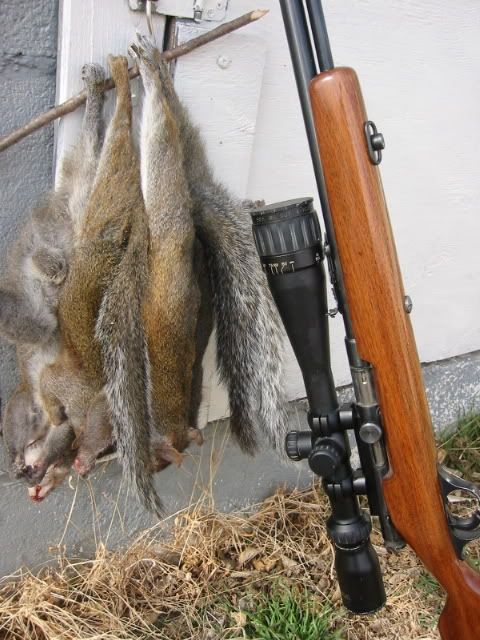I like mine.....built like a tank!
here's some info.............
"GillGuns"or "Clackity~Clacks:
The 87's were a mostly cheaper model with wood stained to look walnut, they were copied from the 1936-1947 model's 76 and 076(best sights). Anything buckhorn, was supposed to be a better rifle ~ wood, sights, etc. Pre-war models sport the checkering on the grip areas. The different models had small changes, i.e. trigger guards, painted stocks, "tenite" plastic stock etc. the models with the "square" receiver ends are: A,AB,AT,B,C,D,K(carbine model). The rifle was changed somewhere around 1958 to have a sloped rear receiver endcap, but it still screwed in....models 87E,KE,J,N,187E,187H,188H~
And we also know that the war era spawned the 87M, A HIGH PRICED garrand copy useing the 87's basic features, with special sights....yeah! Try and find one of those babies! $$$ cha~ching!
"It is probable that in this time (1940) the Springfield 87M was developed as a military-type training rifle."
"Its walnut stock and handguard resembled the Garrand's wood; its tubular magazine had to be withdrawn for loading; its utility was questionable and its production run short. The 87M is seldom encountered today in original configuration. After the war the 87M resurfaced in the Sears Roebuck catalog as the Ranger Model 101.16."
There was also a short lived "gallery" shorts only model 872(Savage 602) circa 1940~
The "clip" models were the same receiver etc as the mag tube models...with different lower cut-outs, only named 85's....85,85A,85K(carbine model)circa 1939. Similar models were 57,& 057 circa 1939-1947, and the 850.
Sears had their models stamped ranger 101 and stuff… westerfield had a 87 marked 808. coast to coast 288, westpoint 287, hiawatha 189-J, hiawatha 189-N & westerfield 808-N. 87J=B-964 belknap, 87N=B-964 belknap.
they look good when they scope mounted with the T and N mounts and a old weaver 29S(1937) or the cheaper weavers G (1947) B (1953) series. (Try Numrich Gunparts - I bought a Weaver accessory scope mount base plate which according to instruction sheet fits many of the Savage 6A variants - it matched the predrilled/plugged holes on our "Ranger 101.16/ Savage 6A" perfectly. Part Number 573370 - not shown in their on-line catalog.)
Savage bought out Stevens in 1920. Savage made the 6 and 7 series~6A,AB,B,C (cheekpiece model) D,S (factory installed peepsights) The 7 was the "clip" model~7, 7A. The factory scoped models were 6E,6H,6DL,6J,6M,6N,6JDL,6P. Sales records show that the #6 started in 1938 with around 9000 units sold in both 1938 and 1939. Might have been a similar amount for 1940 and 41. The Model 7 (clip version) was added in 1939 and it had the gill cuts. I would think that the gills were added (6A) soon after introduction sometime in 1938.
The 6D came out in 1955. It had a grooved receiver for the tip-off mounts.
So, I THINK that the 87 started in 1938 and ended with model changes 1958/61. These changes appeared to be the sloped rear cap, less "fins' on the left of the receiver, and wood finishes.
I think Savage started selling scopes and mounts in 1936 and D&T'ed the receivers in 1937. The receivers were D&T'ed with two hole for the Weaver T mount. The Savage 6A and 7 series which also spawned the Stevens 76A, Springfield 87A and Ranger 101.6. Stevens made the 76A prior to WW II, also the Springfield 87A. After WWII Stevens used the 87A designation. Ranger was the name for Sears prior to 1948 then it went to JC Higgins. These were also made in a box mag fed system. Savage 7/7A, Stevens and Springfield 85.
After WWII Weaver came out with the N mount which had four holes.
Looking in the scope book, I see that the "S" mount was first used in 1934 and the "T" was added in 1939.
Both scopes line up on the C/L of the bore. Mounting hole spacing of both is
approx. 2.35" CTC. The S-1 is called the low (C/L to T/Receiver=.5"), and the
S-3 (C/L to T/Receiver=1.0") is the high mount. These mounts are shown on page
263 & 269 in Nick Stroebel's book, "Old Rifle Scopes. I don't know if there ever
was a S-2 mount, or how it differed from the S-1 & S-3 mounts.
The 150 Savage peep sight with two holes will fit those two holes on the left rear receiver in the 87's & 85's.
Notice too......as we get toward the end of the era, the cheaper manufacturing techniques...the extractors are no longer spring loaded little hooks, but a one piece spring clip....also the EARLY 87's had no peep sight or "n" scope mount holes on the receiver ~BUT, nothing is sure here....ALL records are lost, I have been taking notes and old magazine adds to get my info~and last but not least.....the company used what it had.....as I have a factory 87K with a barrel mark "D" on it and have seen another marked the same. I have seen one ranger without ANY fins also! Marks on barrels may help too in the manufacture date~Utica NY until 1947, Chicopee Falls until 1960, Westfield after that.
Thanks be to' Savage99', & 'Sarge' & 'Fatstrat' and others~
Updated 11-26-2009
my biggest stevens





























